- Home
- J. -H. Rosny aîné
The Mysterious Force
The Mysterious Force Read online
The Scientific Romances of
J.-H. Rosny Aîné
THE MYSTERIOUS FORCE
And Other Anomalous Phenomena
translated, annotated and introduced by
Brian Stableford
A Black Coat Press Book
Introduction
This is the third volume of a six-volume collection of stories by J.-H. Rosny Aîné (“the Elder”), which includes all of his scientific romances, plus a number of other stories that have some relevance to his work in that genre.1
The contents of the six volumes are:
Volume 1. THE NAVIGATORS OF SPACE AND OTHER ALIEN ENCOUNTERS: The Xipehuz, The Skeptical Legend, Another World, The Death of the Earth, The Navigators of Space, The Astronauts.
Volume 2. THE WORLD OF THE VARIANTS AND OTHER STRANGE LANDS: Nymphaeum, The Depths of Kyamo, The Wonderful Cave Country, The Voyage, The Great Enigma, The Treasure in the Snow, The Boar Men, In the World of the Variants.
Volume 3. THE MYSTERIOUS FORCE AND OTHER ANOMALOUS PHENOMENA: The Cataclysm, The Mysterious Force, Hareton Ironcastle’s Amazing Adventure.
Volume 4. VAMIREH AND OTHER PREHISTORIC FANTASIES: Vamireh, Eyrimah, Nomaï.
Volume 5. THE GIVREUSE ENIGMA AND OTHER STORIES: Mary’s Garden, The Givreuse Enigma, Adventure in the Wild.
Volume 6. THE YOUNG VAMPIRE AND OTHER CAUTIONARY TALES: The Witch, The Young Vampire, The Supernatural Assassin, Companions of the Universe.
The first volume of the series includes a long general introduction to Rosny’s life and works, which there is no need to repeat here; the following introduction will therefore be limited to a brief account of the stories included in this volume, which will be supplemented by a more detailed commentary contained in an afterword.
“Le Cataclysme” was initially published in 1888 as “Tornadres” and reprinted until the more familiar title in a volume with “Les Xipéhuz” (1887; tr. in vol. 1 as “The Xipehuz”) by the press associated with the Mercure de France in 1896. The latter volume might well have been produced as a direct response to the success in England of H.G. Wells’s early scientific romances—Henry Davray, Wells’s French translator, was on the editorial staff of the Mercure—and certainly had the effect of initiating Rosny’s reputation as a French anticipator of Wells, although it was issued at a time when Rosny had abandoned such work, and was not to resume his experiments in speculative fiction for more than a decade.
Like its companion-piece, “Le Cataclysme” can now be seen as spinoff from the speculations that Rosny dramatized in a less conventional fashion in “La Légende sceptique” (1889; tr. in vol. 1 as “The Skeptical Legend”), featuring a temporary interaction between different kinds of matter, initiated by virtue of a cosmic incident. When Rosny returned to the writing of scientific romance, under the influence of Maurice Renard’s propagandizing in favor of “scientific marvel fiction,” he picked up the theme of “Le Cataclysme” for much more elaborate development in La Force mystérieuse, which was serialized in Je Sais Tout in 1913 before being reprinted in book form by Plon in the following year. Rosny subsequently produced an abridged version of the latter story for publication alongside “Les Xipéhuz” and “La Mort de la Terre” (1912; tr. in vol. 1 as “The Death of the Earth”) in the collection Les Autres vies et les autres mondes (Cres, 1924) but I have reproduced the fuller version here.
The third item translated here, L’Etonnant voyage de Hareton Ironcastle, was issued by Ernest Flammarion in 1922 in a series of Romans aventures, for which it might have been specifically commissioned. Flammarion had become Rosny’s primary publisher during the war, after a substantial gap in the author’s production, following the propagandistic Perdus? [Doomed?] (1917) and Confidences sur l’amitié des tranchées [Secrets of Friendship in the Trenches] with three sentimental novels and reprints of several of his earlier works in the latter vein. In addition to Rosny’s full-length books, Flammarion issued two novelettes by Rosny as booklets in a series entitled Une heure d’oubli, both of which were imaginative fiction, presumably written to order: La Jeune Vampire (1920; tr. in vol. 6 as “The Young Vampire”) and Le Trésor dans le neige (1920; tr. in vol. 2 as “The Treasure in the Snow”). The structure of the narrative of L’Etonnant voyage de Hareton Ironcastle suggests that part three of the extant text might well have started out as another exercise in the same vein, but that it grew too long, with the result that Rosny decided—or was advised—to add the preliminary material to convert the novelette into a novel. On the other hand, the fact that L’Etonnant voyage de Hareton Ironcastle features an American hero might reflect an ambition to have the story translated; Rosny may well have been aware in 1921 that translation rights to his novel Le Félin géant (1918 as a serial; 1920 in book form; tr. as The Giant Cat, 1924) had been sold in the USA.
Although L’Etonnant voyage de Hareton Ironcastle did not sell translation rights at the time of writing, it was eventually translated into English for publication by DAW books in 1976 as Ironcastle, but that translation was handed over by DAW’s proprietor, Donald A. Wollheim, for extensive modification by Philip José Farmer. Although Farmer’s revisions fill in some lacunae in Rosny’s rather hurried text, thus smoothing it out, and definitely qualify as improvements from the viewpoint of the casual reader, the fact remains that the DAW text is not a true reflection of what Rosny actually wrote, and I think that the present, more accurate, translation is therefore justifiable.
Oddly enough, Don Wollheim’s primary reason for commissioning the revision—as he explained to me on the one occasion when I met him, while Ironcastle was in press—was that he felt it unacceptable, in the context of an adventure story, that Hareton Ironcastle should spend so much time praying. The only reason the character does that, however—it is not something that Rosny or any of his other male heroes would ever have thought of doing, although weak women (like Luce in “Le Cataclysme”) often fall back upon prayer in times of crisis—was that Rosny was trying to make him into a plausible American, and had evidently formed the impression that Americans tend to be pious Bible-addicts. As to how he had formed that impression, we can only guess. I, of course, have left the praying in, along with the frequent references to the Bible made by Ironcastle and his sister.
Ironically, from the viewpoint of the present exercise, one of the effects of Farmer’s modifications was to convert Ironcastle into a story of the same kind as “Le Cataclysme” and La Force mystérieuse, explaining the anomalous life-forms encountered in the final phase of the story as the result of an intrusion of extraterrestrial life on the Earth’s surface. Although Rosny does not specifically exclude that hypothesis, there is no evidence to support that interpretation in the original text; even so, the exoticism of the “alternative evolution” featured in the story is considerably greater than the hypothetical constructions featured in the lost land stories collected in volume two of the series, so the novel is as fittingly located here as it would have been there.
The version of “Le Cataclysme” from which I derived my translation is the one in the 1896 Mercure de France volume. The version of La Force mystérieuse I used is a reprint of the Plon book. I used the 1922 Flammarion edition of L’Etonnant voyage de Hareton Ironcastle.
Brian Stableford
THE CATACLYSM
I. Symptoms
On the Tornadre plateau, for several weeks, nature palpitated and equivocated in anguish, the whole of its delicate vegetable organism shot through by intermittent electricity, symbolic signs of a great material event. The free beasts on the farms and in the chestnut plantations were not as quick to flee quotidian perils; they seemed to want to get closer to human beings, wandering around the tenancies. Then they came to an extraordinary decision, soundi
ng an alarm: they emigrated, going deep into the valley of the Iaraze.
As the nights fell, in the gloom of forests and thickets, there was a drama of nervous animals furtively quitting their lairs with hesitant steps, often pausing and stopping, melancholy to be fleeing their native land. The somber and languid howling of wolves alternated with the muffled grunts of wild boars and the sobbing of ruminants. Ashy silhouettes were gliding everywhere, generally toward the south-west, over cultivated ground beneath the open sky: great antlered skulls, heavy tapir-like bodies with short legs, and slimmer beasts, carnivores and herbivores alike—hares, moles, rabbits, foxes and squirrels. The batrachians followed, the reptiles and the wingless insects, and a week ensued in which the south-western direction was flooded with inferior organisms, a frightful vermicular population, from the hopping silhouettes of frogs to slugs and snails, through the marvelous wing-cases of carabid beetles and horrible crustaceans that live under stones in eternal darkness, to worms, leeches and larvae.
Soon, nothing remained but winged creatures. Then the birds, filled with unease, increasingly clinging on to branches, fearful of flying, saluted the twilights with more subdued songs, often leaving the locality for a large part of the day. The crows and the owls held great assemblies; the swifts gathered together as if for their autumnal migration; the magpies became agitated, cawing all day long.
The mysterious terror spread to the slaves: the sheep, the cattle, the horses, even the dogs. Resigned, in the confidence of their humble serfdom, all expecting salvation from humankind, they stayed on the Tornadre plateau—except for the cats, which had fled in the early days, returning to savage liberty.
As the evenings went by, a confused sadness, an asphyxia of the soul, took possession of the inhabitants of the tenancies and the proprietors of the estate known as the Corne: the confused anticipation of a cataclysm—which, however, the topography of Tornadre belied. Being distant from volcanic regions and the ocean, insubmersible—having only a few streams—and compact in texture, what form could the threat possibly take?
It was felt nevertheless, electrically, in the rigidity of small branches and blades of grass at certain morning hours, in the singular attitudes of foliage, in subtle and suffocating effluvia, unusual phosphorescences and the prickling of flesh by night, which caused the eyelids to rise, condemning the individual to insomnia, in the extraordinary behavior of livestock, often stiffening, their nostrils open and tremulous, and turning their heads toward the north.
II. The Astral Downpour
One evening, at the Corne, Sévère and his wife were finishing dinner next to the half-closed window. A crescent moon was wandering near the zenith, pale and full of grace, above the vast perspectives, and rising mists decorated the western frontier. A troubling spell—an ardor of the nervous system, a suddenly awakened obscure commotion—kept them silent, impregnating them with a particular aesthetic sensibility, a profound wonderment relative to the nocturnal splendors.
A harmonious tremor welled up from the trees in the garden; at the rear, visible through the gate to the avenue, there was an enchantment of confused objects, the crop-fields of the Tornadre, the blanched farmhouses, the friendly mystery of human lights and the vague slate-covered steeple of the rustic church. The masters of the Corne were moved by that, troubled by the vibration of their nerves. The commotion being keener along the spinal column, however, the wife dropped the bunch of grapes that she was plucking, her lip trembling.
“My God! Is it going to go on forever?”
Sévère looked at her, with a strong desire to give her courage—but his own soul was in a stupor, obscured by an imponderable force.
Sévère Lestang was one of those grave intellectuals slowly seeking the secret of things, studying nature without impatience, disinterested in glory—but he was a man as well as an intellectual; his eyes were gentle and courageous, and he had a desire to live his life as well as developing his faculties. His wife, Luce, was a nervous mountain Celt, delicately graceful, amorous and captivating, but a trifle somber. Under the calm and attentive protection of her husband, she was like certain infinitely frail flowers that live in the inlets of great rivers, between large shady leaves.
“If you want,” said Sévère, “we can leave tomorrow.”
“Yes, please!”
She came closer to him, seeking refuge, murmuring: “They say that one can’t keep a foothold any longer, you know, especially in the evening…that something takes hold of you and carries you away! Well, I don’t dare walk quickly any longer, my steps draw me on so…and one climbs stairs effortlessly, but with a constant fear of falling…”
“You’re mistaken, Luce. It’s a nervous illusion.” He smiled, pressing her to him—but he too, with a terrible malaise, had perceived that incomprehensible lightness. Sometimes, before dusk, had he not wanted to walk more rapidly, to get back to the Corne, and found his stride lengthening, transformed into bounds, launching him forward with frightening speed? With his equilibrium lost, having difficulty in remaining vertical, experiencing a sensation of ataxia at each footfall, he had reverted to a slow pace, clinging to the ground, solidly, seeking large patches of sticky ground.
“You think it’s an illusion?” she said.
“I’m sure of it, Luce!”
She looked at him, while he stroked the fringe of her hair, and she suddenly realized that he was as nervous as she was, electrified by a profound anguish: no longer a refuge for her, but a poor frail creature confronted by enigmatic powers.
Then she went paler, her teeth chattering.
“The coffee will settle you,” he said.
“Perhaps.”
But they sensed the deceit in their words, the poverty of any tonic, or any human remedy against the approaching Unknowable—against that vast metamorphosis of phenomena, in which terrestrial life no longer participated, which had been troubling the flora and fauna, the animals and the plants, for weeks already.
They sensed the deceit. They did not dare look at one another, instinctively afraid of communicating their presentiments, of doubling their distress by nervous induction. And for long minutes, they listened inwardly, in their flesh, to the dull and confused echo of Mystery.
A fearful housemaid brought the coffee; they watched her leave, unsteadily, not daring to question that anxiety, similar to their own.
“Did you see how Marthe was walking?” asked Luce.
He did not reply, looking in surprise at the little silver spoon that he had just picked up. Perceiving his fixed stare, she looked at it in her turn, and exclaimed: “It’s green!”
The little spoon was, indeed, green, with a pale emerald gleam—and they suddenly noticed the same tint on the other spoons, and all of the silverware.
“Oh, my God!” cried the young woman. Raising her finger, she began to recite, in a low voice, whispering painfully:
“When the Silver goes green,
“The Roge Aigue will come
“Devouring the Moon and stars…”2
These words, an ancient and vague prophecy that the peasants of the Tornadre plateau had handed down through the ages, made Sévère shudder. They both had an impression of darkness and fatality, colorless and soundless, beyond all anthropomorphism. Where had the poor rustics obtained that oracle, now so serious? What science, what observations of remote eras, what cataclysmic memories, did it symbolize?
Sévère had an immense desire to be far away from Tornadre, remorseful at not having obeyed the sure instincts of the animals, at having dared to follow poor cerebral logic rather than the warning of Nature. “Do you want to leave this evening?” he asked Luce, ardently.
“I’d never dare leave the house before morning returns!”
He thought that it might be as perilous to venture out by night as to stay at the Corne; he resigned himself to it, thoughtfully. A great lamentation interrupted his thoughts: feverish whinnying, the dull banging of horses struggling against the stable-door. The dog howled, and the clam
or spread along the length of the Tornadre plateau, echoed by other animals, terrified ruminants and braying donkeys. At the same time, there was a greenish glow in the sky, and a shooting star passed over, huge, with a resplendent tail.
“Look!” said Luce.
Other meteors welled up, isolated at first, then in small groups, all with bright nuclei and leaving long trails, miraculously beautiful.
“It’s the night of August 10,” said Sévère, “and the star-showers will increase…there’s nothing abnormal about it.”3
“Why, then, are our lamps growing dimmer?”
The Lamps were, in fact, lowering their flames; a superior electrical density enveloped everything, a terror, not of death, but of exasperated life, of supernatural dilatation—so that Sévère and Luce clung on to the furniture in order to weigh more, in order to perceive contact with solid material. A strange pressure lifted them up, robbing them of their sense of balance. They felt that they were in a new atmosphere, in which the ether acted with a living power, in which something organic—extra-terrestrially organic—was disturbing every drop of blood, orientating every molecule, intruding into the very marrow of their bones, and gradually stiffening every hair on their bodies.
In addition, as Sévère had predicted, the stellar downpour accelerated, the entire concavity of the firmament filling with bolides. By degrees, it was mingled with an unknown phenomenon, persistent and increasing: voices. Faint, distant, musical voices, a symphony of tiny strings in the celestial depths, a sometimes almost human whisper, reminiscent of the ancient Pythagorean harmony of the spheres.
“They’re souls!” she murmured.
“No,” he said. “No, they’re Forces!”
Souls or forces, however, it was the same Unknown, the same hermetic threat, the pressure of a prodigious event, the blackest of human fears: the Shapeless and the Unforeseeable. And the voices went on, above the murmur of things, frightfully gentle, essential and subtle, taking Luce back to the Humility of childhood, to Worship, to Prayer:

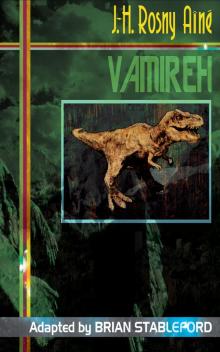 Vamireh
Vamireh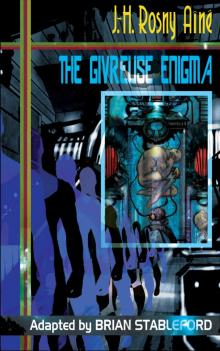 The Givreuse Enigma
The Givreuse Enigma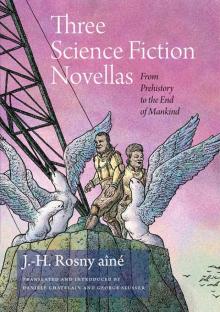 Three Science Fiction Novellas: From Prehistory to the End of Mankind
Three Science Fiction Novellas: From Prehistory to the End of Mankind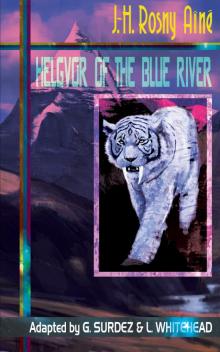 Helgvor of the Blue River
Helgvor of the Blue River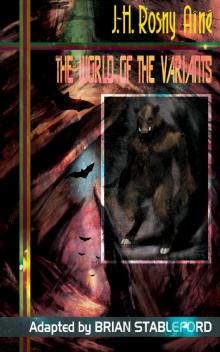 The World of the Variants
The World of the Variants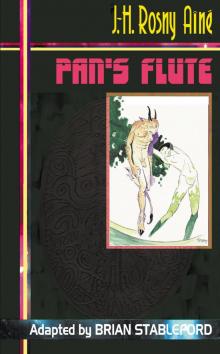 Pan's Flute
Pan's Flute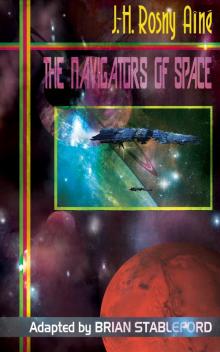 The Navigators of Space
The Navigators of Space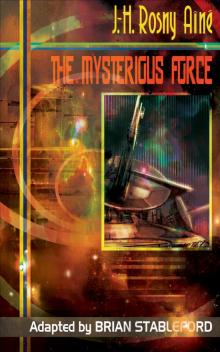 The Mysterious Force
The Mysterious Force